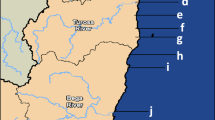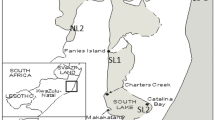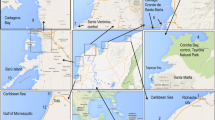Abstract
Analyses of the concentrations of Cd, Cr, Co, Cu, Fe, Pb, Mn, Hg, Ni, and Zn in filtered waters, suspended particulates, sediments, shellfish, fish, airborne particulates, and sewage have confirmed work of other investigators showing that the Derwent Estuary is heavily contaminated, particularly withmercury, cadmium, lead, andzinc, and have added further information regarding the distribution of each metal. Apparently most of the contamination originated from the earlier operation of a zinc refining plant. A study of shellfish growing in variously contaminated regions found that more than 20 species could be listed in order of their respective abilities to accumulate each heavy metal. For example, the mussel (Mytilus edulis) was found to be a good indicator of cadmium and mercury contamination, but less valuable as an indicator of zinc. The surf barnacle, (Catophragmus polymerus) was found to be one of the most sensitive biological indicators of cadmium contamination. An indication of the steps by which a waste metal is eventually accumulated at high and even toxic concentrations in seafoods, may be seen from a comparison of the relative concentrations of cadmium, lead, mercury, and zinc found in mussels, sediments, suspended particulates, and filtered waters. The high concentrations recorded for metals include: 1,100 µg/g Hg, 10,000 µg/g Zn, and 862 µg/g Cd in dried sediments; 1,500 µg/g Cd in airborne dust fallout; 200 µg/g Cd and 100,000 µg/g Zn in dried oysters; and 16 µg/l Hg, 15 µg/l Cd and 1,500 µg/l Zn in filtered waters.
Similar content being viewed by others
References
Abdullah, M. I., and L. G. Royle, 1972, Heavy metal content of rivers and lakes in Wales: Nature, v. 238, p. 329.
Abdullah, M. I., L. G. Royle, and A. W. Morris, 1972, Heavy concentration in coastal waters: Nature, v. 235, p. 158–160.
Anon., 1968, Undersökningar för havsuts lapp år 1966–1967: Göteborgs Vattenvårdsanläggningar, 210 p.
Anon., 1974, Heavy metals in the marine environment of the North Coast of Tasmania: report on a survey, November 1973: Department of the Environment, Hobart, 87 p.
Ayling, G. M., 1974a, Preservation of traces of heavy metals in samples: paper presented to AWRC/AWWA/RACI Symposium Water Sampling and Analysis Techniques, Canberra, August 1974.
—— 1974b, Uptake of cadmium, zinc, copper, lead and in the Pacific oyster,Crassostrea gigas, grown in the Tamar Tasmania: Water Res., v. 8, p. 729–738.
—— 1975, The environmental influence on the uptake of by shellfish: paper presented at Environment '75, Syndney (1–4 July, v. 3, p. 237–246.
Ayling, G. M., and H. Bloom, 1976, Heavy metals analyses to and estimate distribution of heavy metals in dust fallout: Atm Environ., v. 10, p. 61–64.
Belyayev, Yn. I., and V. V. Gordeyev, 1972, Determination of ganese, silver, lead and cadmium in sea water suspension by absorption with an arc atomizer: Okeanologiya, v. 12, no. 5, p. –910.
Bond, R. G., and C. P. Straub, 1973, Handbook of environmental Vol. III, Water supply and treatment: Cleveland, CRC Press, p. –781.
Brooks, R. R., R. J. Presley, and I. R. Kaplan, 1967, APDC-extraction system for the determination of trace elements in waters by atomic absorption spectrophotometry: Talanta, v. 14, 809–816.
Bruland, K. W., K. Bertine, M. Koide, and E. D. Goldberg, History of metal pollution in southern California coastal zone: Sci. Technol., v. 8, p. 425–432.
Chester, R., and J. H. Stoner, 1975, Trace elements in total particular material from surface sea water: Nature, v. 255, p. 50–51.
Clifton, A. P., and C. M. G. Vivian, 1975, Retention of mercury from a industrial source in Swansea Bay sediments: Nature, v. 253, p. –622.
Cooke, N. E., and A. Birtel, 1971, Some aspects of other sources mercury in the environment,in Mercury in man's environment: Roy. Soc. Canad., Symp., Feb. 15–16, p. 53.
Copeland, R. A., 1972, Mercury in the Lake Michigan environment, Hartung, R., and B. D. Dinman, eds., Environmental mercury tamination: Ann Arbor, Ann Arbor Science Publishers, p. 71–76.
Cranston, R. E., and D. E. Buckley, 1972, Mercury pathways in a estuary: Environ. Sci. Technol., v. 6, no. 3, p. 274–278.
Dall'Aglio, M., 1968, The abundance of mercury in 300 natural samples from Tuscany and Latium,in Ahrens, L. H., ed., Origin at distribution of elements: New York, Pergamon Press, p. 1065.
Director of Environmental Control, 1972, Environmental pollution Tasmania: Government Printer, Rept. Dept. Environment, no. 74, 18 p.
Director of Environmental Control, 1973, Report for Year 1972– Government Printer, Dept. Environment, Tasmania, no. 73, 19 p.
-- 1974, Report for Year 1973–74: Government Printer, Environment, Tasmania, no. 87, 22 p.
Dix, T. G., A. Martin, G. M. Ayling, K. C. Wilson, and D. A. Ratkowsky, 1975, Sand flathead (Platycephalus bassensis) and indicator species for mercury pollution in Australian waters: Mar. Pollut. Bull., v. 6, p. 142–144.
Durum, W. H., J. D. Hem, and S. G. Heidel, 1971, Reconnaissance of selected minor elements in surface waters of the United States: Oct., 1970: U.S. Geol. Survey Circ. 643, 49 p.
Elderfield, H., L. Thornton, and J. S. Webb, 1971, Heavy metals and oyster culture in Wales: Mar. Pollut. Bull., v. 2, p. 44–47.
Eustace, I. J., 1974, Zinc, cadmium, copper and manganese in species of finfish and shellfish caught in the Derwent Estuary: Aust. Jour. Mar. Freshwat. Res., v. 25, p. 209–220.
Fleischer, M., A. F. Garofim, D. W. Fassett, P. Hammond, H. T. Shacklette, I. C. T. Nisbet, and S. Epstein, 1974, Environmental impact of cadmium: a review by the panel on hazardous trace substances: Environmental Health Perspectives, May, p. 253–323.
Friberg, L., M. Piscator, and G. Nordberg, 1971, Cadmium in the environment: Cleveland, CRC Press, 166 p.
Friberg, L., M. Piscator, G. F. Nordberg, and T. Kjellstrom, 1974, Cadmium in the environment: Cleveland, CRC Press, p. 156.
Greszta, J., and S. Godzik, 1969, Effect of zinc metallurgy on soils: Rocz. Gleboznawcze, v. 20, p. 195.
Haigh, C. J., and R. W. Pickering, 1969, The treatment of zinc plant residue at the Risdon Works of the Electrolytic Zinc Company of Australia Limited: Electrolytic Zinc Company Report, Hobart.
Hasselrot, T., 1968a, Communication inDagens Nyheter, 28 June,cited by Ackefors, H., G. Löfroth, and C-G. Rosen, 1970, A survey of the mercury pollution problem in Sweden with special reference to fish: Oceanog. Mar. Biol. Ann. Rev., v. 8, p. 203–224.
—— 1968b, Report on current field investigations concerning the mercury content in fish, bottom sediment, and water: Rep. Inst. Freshwater Res., v. 48, p. 102.
-- Hasselrot, T. 1969, Field investigations concerning the occurrence of mercury in fish, water, bottom sediment and bottom organisms: Report to the Research Board of the National Environmental Protection Board, Stencils.
Her Majesty's Stationary Office, 1973, Survey of cadmium in food: London, Her Majesty's Stationary Office, 32 p.
Hoggins, F. E., and R. R. Brooks, 1973, Natural dispersion of mercury from Puhipuhi, Northland, New Zealand: New Zealand Jour. Mar. Freshwat. Res., v. 7, p. 125–132.
Horvath, G. J., R. C. Harriss, and H. C. Mattraw, 1972, Land development and heavy metal distribution in the Florida Everglades: Mar. Pollut. Bull., v. 3, p. 182.
Ireland, M. P., 1973, Result of fluvial zinc pollution on the zinc content of littoral and sub-littoral organisms in Cardigan Bay, Wales: Environ. Pollut., no. 4, p. 27–35.
Isaac, R. A., and J. Delaney, 1973, Toxic element survey; Progress Rept. 1: Mass. Water Resources Comm., Div. Water Pollution Control, Pub. no. 6108.
Jaakkola, T., H. Takahashi, and J. K. Miettinen, 1974, Cadmium content in sea water, bottom sediments, fish, lichen, and elk in Finland: Report, World Health Org. Meeting, Geneva, 8–13 Feb.
Jonasson, I. R., and R. W. Boyle, 1971, Geochemistry of mercury: Proc. Royal Society of Canada, Symp., Mercury in man's environment, Ottawa.
Kato, T., and S. Kawano, 1968, Review of past and present of itai-itai disease. On the process of research development: Curr. Med., v. 16, p. 29.
Kitamura, S., 1968, Determination of mercury content in bodies of inhabitants, cats, fishes and shells in Minamata District and in the mud of Minamata Bay, in Minamata Disease: Tokyo, Shuhan Co., p. 257–266.
Klein, D. H., and E. D. Goldberg, 1970, Mercury in the marine environment: Environ. Sci. Technol., v. 4, p. 765–768.
Konrad, J. G., 1972, Mercury contents of bottom sediments from Wisconsin rivers and lakes,in Hartung, R., and B. D. Dinman, eds., Environmental mercury contamination: Ann Arbor, Ann Arbor Science Publishers, p. 52–58.
Kurland, L. T., S. N. Faro, and H. Siedler, 1960, Minamata disease: the outbreak of a neurologic disorder in Minamata, Japan, and its relationship to the ingestion of seafood contaminated by mercuric compounds: World Neurol., v. 1, p. 370.
Ljunggren, K., B. Sjöstrand, D. Hagman, and T. Westermark, 1969, Recent experience in activation analysis: Nord. Hyg. T., v. 50, p. 75.
Major, G. A., 1972, M.App.Sc. Thesis, University of New South Wales.
-- 1973, Zinc in the marine environment: Aust. Mar. Sci. Assoc. Ann. Conf. (Rottnest Island, Western Australia), August, 11 p.
Mink, L. L., R. E. Williams, and A. T. Wallace, 1971a, Analysis of an aquatic environment receiving domestic and industrial effluent: Univ. Missouri, Proc. Columbia 4th Ann. Conf. Trace Substances in Environmental Health, 1970, p. 69–84.
-- 1971b, Effect of industrial and domestic effluents on the water quality of the Coeur d' Alene River basin, 1969 and 1970: Idaho Bur. Mines and Geol., Pamphlet no. 149, 30 p.
Nickless, G., R. Stenner, and N. Terrille, 1972, Distribution of cadmium, lead and zinc in the Bristol Channel: Mar. Pollut. Bull., v. 3, p. 188–190.
Nix, J., and T. Goodwin, 1970, The simultaneous extraction of iron, manganese, copper, cobalt, nickel, chromium, lead, and zinc from natural water for determination by atomic absorption spectroscopy: Atomic Absorption Newsletter, v. 9, p. 119–122.
Piscator, M., 1971,in Friberg, L., M. Piscator, and G. Nordberg, Cadmium in the environment: Cleveland, CRC Press.
Preston, A., D. F. Jeffries, J. W. R. Dutton, B. R. Harvey, and A. K. Steele, 1972, British Isles coastal waters: the concentrations of selected heavy metals in sea water, suspended matter and biological indicators—a pilot survey: Environ. Pollut., no. 3, p. 69–82.
Ratkowsky, D. A., S. J. Thrower, I. J. Eustace, and June Olley, 1974a, A numerical study of the concentration of some heavy metals in Tasmanian oysters: Jour. Fish. Res. Bd. Canada, v. 31, no. 7, p. 1165–1171.
Ratkowsky, D. A., T. G. Dix, and K. C. Wilson, 1974b, Mercury in fish in the Derwent Estuary, Tasmania, and its relation to the position of the fish in the food chain: Hobart, Commonwealth Scientific and Industrial Research Office (CSIRO), Internal Report.
Riley, J. P., and D. Taylor, 1968, Chelating resins for the concentrations of trace elements from sea water and their analytical use in conjunction with atomic absorption spectrophotometry: Anal. Chim. Acta, v. 40, p. 479.
Robertson, D. E., 1968, Role of contamination in trace element analysis of sea water: Anal. Chem. Acta, v. 40, p. 1067–1072.
Rojahn, T., 1972, Determination of copper, lead, cadmium and zinc in estuarine water by anodic-stripping voltammetry on the hanging mercury drop electrode: Anal. Chim. Acta, v. 62, p. 438.
Senate Select Committee, 1970, Water pollution in Australia: Canberra, Commonwealth Government Printing Office, v. 15, 214 p.
Takeuchi, T., M. Morikawa, H. Matsumoto, and Y. Shiraishi, 1962, A pathologic study of Minamata disease in Japan: Acta Neuropathologica, v. 2, p. 40–57.
Takeuchi, T., 1972, Distribution of mercury in the environment of Minamata Bay and the Inland Ariake Sea,in Hartung, R., and B. D. Dinman, eds., Environmental mercury contamination: Ann Arbor, Ann Arbor Science Publishers, p. 79–81.
Thomas, R. L., 1972, The distribution of mercury in the sediments of Lake Ontario: Can. Jour. Earth Sci., v. 9, p. 636.
Thrower, S. J., and I. J. Eustace, 1973a, Heavy metals in Tasmanian oysters in the winter of 1972: Aust. Fish., v. 32, no. 10, p. 7–10.
—— 1973b. Heavy metal accumulation in oysters grown in Tasmanian waters: Food Technol. Aust., v. 25, p. 546–553.
Van As, D., H. O. Fourie, and Constance M. Vleggaar, 1973, Accumulation of certain trace elements in marine organisms from the sea around the Cape of Good Hope: Radioactive Contamination of the Marine Environment, Internat. Atomic Energy Agency, Vienna, IAEA-SM-158/39, p. 615–624.
Van Loon, J. C., J. Lichwa, D. Rutton, and J. Kinrade, 1973, The determination of heavy metals in domestic sewage treatment plant wastes: Water Air Soil. Pollut., v. 2, p. 473–482.
Walter, C. M., F. C. June, and H. G. Brown, 1973, Mercury in fish, sediments, and water in Lake Oahe, South Dakota: Jour. Water Pollut. Cont. Fed., v. 45, no. 10, p. 2203–2210.
Weiler, R. R., and V. K. Chawla, 1972, Chemical composition of Lake Erie: Proc. 11th Cong. Great Lakes Research, Burlington, Ont., 1968, v. 71, no. 6, p. 593.
Wershaw, R. L., 1970, Sources and behavior of mercury in surface waters,in Mercury in the environment: U.S. Geological Survey Prof. Paper no. 713, p. 29.
Wiklander, L., 1968, Mercury in subsoil water and river water: Grundförbättning, v. 4, p. 151.
Yamagata, N., and I. Shigematsu, 1970,in Cadmium pollution in perspective: Bull. Inst. Public Health, Tokyo, v. 19, p. 1.
Yamamoto, Y., 1972, Present status of cadmium environmental pollution: Kankyo Hoken Report No. 11, Japanese Assoc. for Public Health, April, v. 7.
Author information
Authors and Affiliations
Rights and permissions
About this article
Cite this article
Bloom, H., Ayling, G.M. Heavy metals in the Derwent Estuary. Geo 2, 3–22 (1977). https://doi.org/10.1007/BF02430661
Issue Date:
DOI: https://doi.org/10.1007/BF02430661




